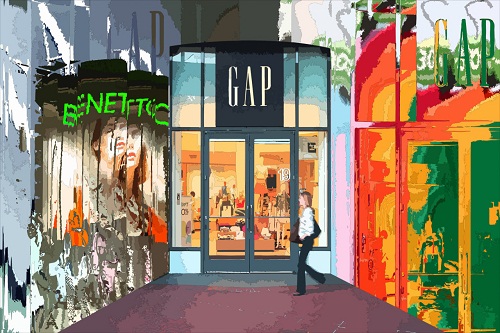 Once renowned as ‘category killers’, fashion retailers Gap and Benetton now face an uncertain future with Gap closing all its stores across the UK and Ireland, and Benetton no longer being in demand. However, the brands continue to inspire fashion lovers across the world with their rich history wrote Thomas R Bukley in the article ‘How clothing giant Gap and Benetton once ruled the fashion street’ first published in The Conversation.
Once renowned as ‘category killers’, fashion retailers Gap and Benetton now face an uncertain future with Gap closing all its stores across the UK and Ireland, and Benetton no longer being in demand. However, the brands continue to inspire fashion lovers across the world with their rich history wrote Thomas R Bukley in the article ‘How clothing giant Gap and Benetton once ruled the fashion street’ first published in The Conversation.
Founded in 1969 by Donald Fisher, Gap, from its inception, focused on its target consumer group. The brand aimed to attract college students and the counterculture generation, and opened its first store near the San Francisco State University. Gap initially sold records to attract customers. These were priced moderately and had enough potential to lure customers. The brand is credited with changing the way Americans shopped and dressed. It was instrumental in leading their change from denims to khakis and T-shirts. By redesigning stores, Gap focused on offering a few products at affordable prices at convenient locations. It also adopted new technologies to control inventory which enabled to satisfy customer demand.
Meanwhile Benetton opened multiple stores in local markets during the 1970. This helped the brand generate high sales volume, and manage distribution network more efficiently.
network more efficiently.
Bright colors, tight inventory keys to Benetton’s success
Bukley explains, a key quality that sets Benetton apart from competitors is its bright color palatte. The brand dyes garment at the last minute which helps it to be flexible and make alterations as per demand. Also, Benetton uses a sophisticated mechanism to control inventory and organize suppliers’ network. Most of the brand’s suppliers are located in Northeast Italy which enables it to efficiently plan supplies besides designing and manufacturing clothes as per demand.
Other retailers also tried to emulate Gap’s and Benetton’s strategies. For instance, run by Amancio Ortega, a Spanish clothing manufacturer opened its first Zara store in 1975. It focused on satisfying changing customer demand at speed.
Laying future foundation
Opportunities for retailers to increase Asia sourcing surged with accelerated adoption of new technologies. This also led to the formation of buyer-driven global value chains in the clothing industry. The pioneers of this change were Gap and Benetton who through their focus on convenience and change laid the foundation of future industry. Since then, the power of these two brands has diminished. However, their business approach continues to remain influential.
With rising environmental awareness and e-commerce acceleration, the business acumen of these two companies continues to inspire future generation brands.












